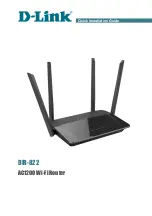
•
You can control logging messages. ACL entries can be set to log traffic only at certain times of the day.
Therefore, you can simply deny access without needing to analyze many logs generated during peak
hours.
Time-based access lists trigger CPU activity because the new configuration of the access list must be merged
with other features and the combined configuration loaded into the hardware memory. For this reason, you
should be careful not to have several access lists configured to take affect in close succession (within a small
number of minutes of each other.)
The time range relies on the switch system clock; therefore, you need a reliable clock source. We
recommend that you use Network Time Protocol (NTP) to synchronize the switch clock.
Note
IPv4 ACL Interface Considerations
When you apply the
ip access-group
interface configuration command to a Layer 3 interface (an SVI, a Layer
3 EtherChannel, or a routed port), the interface must have been configured with an IP address. Layer 3 access
groups filter packets that are routed or are received by Layer 3 processes on the CPU. They do not affect
packets bridged within a VLAN.
For inbound ACLs, after receiving a packet, the switch checks the packet against the ACL. If the ACL permits
the packet, the switch continues to process the packet. If the ACL rejects the packet, the switch discards the
packet.
For outbound ACLs, after receiving and routing a packet to a controlled interface, the switch checks the packet
against the ACL. If the ACL permits the packet, the switch sends the packet. If the ACL rejects the packet,
the switch discards the packet.
By default, the input interface sends ICMP Unreachable messages whenever a packet is discarded, regardless
of whether the packet was discarded because of an ACL on the input interface or because of an ACL on the
output interface. ICMP Unreachables are normally limited to no more than one every one-half second per
input interface, but this can be changed by using the
ip icmp rate-limit unreachable
global configuration
command.
When you apply an undefined ACL to an interface, the switch acts as if the ACL has not been applied to the
interface and permits all packets. Remember this behavior if you use undefined ACLs for network security.
Apply an Access Control List to an Interface
With some protocols, you can apply up to two access lists to an interface: one inbound access list and one
outbound access list. With other protocols, you apply only one access list that checks both inbound and
outbound packets.
If the access list is inbound, when a device receives a packet, Cisco software checks the access list
’
s criteria
statements for a match. If the packet is permitted, the software continues to process the packet. If the packet
is denied, the software discards the packet.
If the access list is outbound, after receiving and routing a packet to the outbound interface, Cisco software
checks the access list
’
s criteria statements for a match. If the packet is permitted, the software transmits the
packet. If the packet is denied, the software discards the packet.
Consolidated Platform Configuration Guide, Cisco IOS Release 15.2(4)E (Catalyst 2960-X Switches)
1181
Information About Configuring IPv4 Access Control Lists
Summary of Contents for Catalyst 2960 Series
Page 96: ......
Page 196: ......
Page 250: ......
Page 292: ......
Page 488: ......
Page 589: ...P A R T VI Cisco Flexible NetFlow Configuring NetFlow Lite page 509 ...
Page 590: ......
Page 619: ...P A R T VII QoS Configuring QoS page 539 Configuring Auto QoS page 645 ...
Page 620: ......
Page 750: ......
Page 1604: ......
Page 1740: ......
Page 2105: ...P A R T XII Configuring Cisco IOS IP SLAs Configuring Cisco IP SLAs page 2025 ...
Page 2106: ......
Page 2118: ......
Page 2164: ......
















































